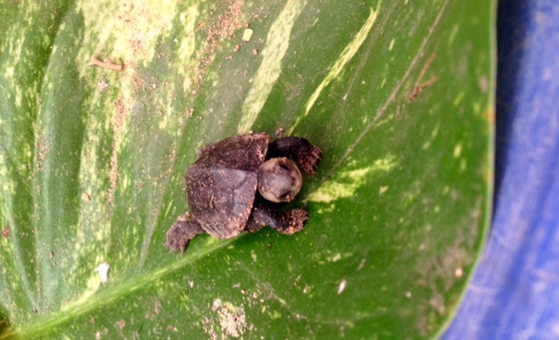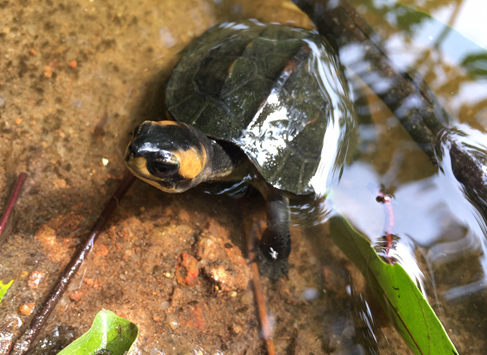
Home >> Gardening >> Turtles Part I
| Home | Source Reduction | Friends of Green Friends | Newsletters |
| Gardening | Resources | What You Can Do | Embracing The Trees |
| Turtle Stories of the Amrita Nature Sanctuary for Native Wildlife - Part II |
| (Continued from Turtle Stories of the Amrita Nature Sanctuary for Native Wildlife - Part I ...)
Over the years, at least 30 of the 100 or more turtles have become regular visitors for occasional snacks and affection. As each has distinct features and very different personalities, we name them and recognize them even after many years. Some turtles even know their specific names and come when we call them. Most come as babies, or young turtles but occasionally we win over the adult turtles who also start to become friendly. This type of turtle is known as the Indian black freshwater turtle and is known to live about twenty five years. In some parts of Asia this type of turtle is a threatened species, but here they thrive in the beautiful sanctuary and enjoy a safe habitat. |
 Baby turtle on banana leaf |
|
After about two years, Amma watched a video of Kurma and his friends and enjoyed it so much she wanted to see it a few times. She asked many questions like what they ate, who feeds them, if they come when we call them, how old they are when they start to lay eggs, and many other questions.
Even to this day Kurma comes occasionally to have snacks. He is full grown, but fearlessly climbs onto our lap to enjoy the most attention. There is high competition for attention amongst the turtles and also the little fish that have started to come to eat the turtle food as well. The distinct personalities of the turtles have provided us a lot of entertainment. Some are very shy and others are not only friendly, but insistent about getting their snacks to the point that they will come running out of the ponds when they hear us passing by and will crawl on our feet and nibble our toes.
|
|
Once a professional film crew sent from the prime minister of India’s office came to film Amma’s ashram projects. When they came to the sanctuary and discovered the turtles, they spent a long time filming them. The turtles were cooperative and enthusiastic stars! On another occasion, as I was working in the garden I found a mother turtle that came right next to me. She felt so comfortable that she dug her nest and laid her eggs right next to me - a process that took a few hours. She even seemed to be comforted by my presence. We discovered that no matter where in the garden the turtles lay their eggs, the newly hatched turtles would find their way to the nearest pond. For this reason we built many small ponds all over the large sanctuary. Amma also told us to protect the turtle’s nests with wire mesh so that snakes and other predators would not eat the eggs. One time I found a newborn turtle in a very small pond and I thought she might like to move to one of the big ponds with the others. She had a very distinct, beautiful yellow face and an inquisitive personality. I named her Uma. I kept Uma in the large pond and she seemed to like it. She was one that would always come when I called her by name. After a year of living in the large pond, one day I found her back in the exact same little pond where she was born, which was very far from the large pond where I had moved her, and one amongst eighteen other ponds spread all over the sanctuary. Another time it happened when I moved a shy, two-year old turtle named Krishna from a little pond to a big one far away. The very next day he returned to his exact same familiar home. That’s when I realized how keen their sense of direction is, and how they can know the exact place they are born, just like the sea turtles that return to the same beaches where they were born to lay their eggs. Only occasionally we had to treat turtles for injuries. Once a turtle was so badly injured and bleeding it looked like he was not going to make it. We kept him in a dry box and gave him frequent soaks with fresh turmeric root and tulasi leaves. We named him Shakti. He recovered quickly and now is healthy and strong and comes to visit us daily. Amma recently saw a video of the sanctuary and even said Kurma’s name aloud and mentioned she would like a documentary made of the turtles and other animals. She even suggested getting a hidden camera to see what the animals do when we are gone! The sanctuary has been the home and safe nesting habitat to numerous animals. Each has their own story, but one particular trait that seems common is their general fearlessness. Other occupants include a family of eagles which raises their babies in the same nest every year, a flock of wild, beautiful ring necked parrots, mongoose, innumerable species of other birds, bats, snakes, butterflies, wild beehives, squirrels and more. Many young children and visitors come to the nature sanctuary and everyone loves feeding and petting the turtles and observing the other wildlife. It has been a great gift from Amma to help us all feel the loving connection with Mother Nature and her creatures. Sarvaga - Amritapuri, India |
Read an interview with a green 8 year-old from the Q1 2021 newsletter >>
| Home | Source Reduction | Friends of Green Friends | Newsletters | Resources | What You Can Do | Contact Us |
For more information, e-mail info@greenfriendsna.org |
||||||
